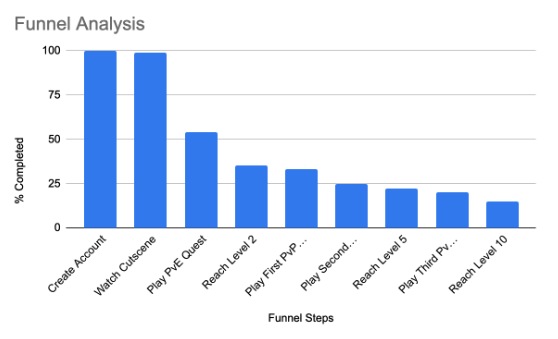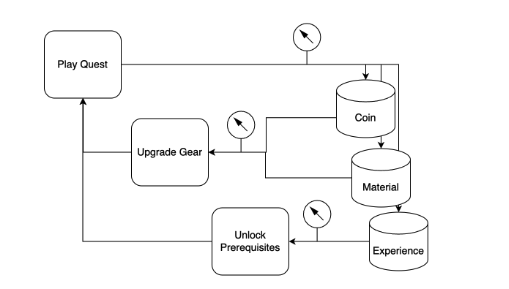Thinking of Video Games as Systems
Making a video game is a team sport. For small studios, this team may consist of two people both working on different aspects of the game. For larger studios including game makers that are running games as a service, the number of stakeholders expands to a range of functions from designers and engineers to data scientists and artists. The more people involved, the more critical it is that everyone is coordinated and making effective decisions. To get there, teams need to communicate effectively and get to a shared context quickly.
The Issue of Data without Context
Imagine working with a team that is looking at early player data for a game. The typical way to do this is to look at something like funnel metrics.
Frequent questions that come about when examining a step in the funnel might include:
Where is that step in the player experience flow?
Why did the players stop and drop out of the funnel there?
Did steps have requirements to be completed?
These questions might be harder than expected to answer. For example, someone analyzing the game may need to look for documentation around the player level requirements to unlock their first PvP quest.
When different pieces of information are in different places or are hard to find, aligning your team around the problem might consume at least one meeting. This is where game system diagrams become important.
Diagramming the Game System
Many articles have been written about game core loops especially in the context of F2P live operated games. While the importance of a coherent core loop is especially important in live operated games for player retention and monetization, loops that reinforce certain gameplay exist in all games. A simple example is shown below for a hypothetical RPG.
Often, diagramming a core loop ends here with a general understanding of the game.
Let’s look at the game as a system.
System diagrams exist for many industrial applications today and allow teams to build complex systems such as power plants with less rework. Likewise, games can also be diagrammed in this way. Below is a conceptual diagram of a game, with gauges where game data can be logged and shed valuable light on game system health. These gauges are windows through which designers, product managers, analysts, or producers might probe into the system and check for its health.
Within context, it is now easier to ask important questions about the health of the system. For example, if the balance of coins increases, we can try to understand if it is an upstream issue (more coins being earned) or a downstream issue (more coins being used). Looking at this diagram, the balance of coins depends on the coins granted by quests and the cost of upgrading gear.
Similarly, looking at the system, we see that player level is a prerequisite to quests, which also allows us to better understand the funnel from earlier.
How This Drives Better Collaboration
Teams make better decisions faster from:
Asking better questions as a team
Gaining shared understanding of the system quickly
Aligning on the core problem to move onto solution discovery
For product managers and business analysts, this means being able to easily point to problem areas and identify where improvements can be made using the same terminology as others on the team.
For game designers, this means being data conversant on the level of an analyst without complicated SQL queries and being able to respond with visual representations of current or desired game logic they would like to design.
For engineers, this means having a clear understanding of what they are implementing, from the game logic to game parameters and data they should add for logging.
Taking the time to sort out the game system also has the added benefit of:
Visibility with QA on expected behavior
Shared knowledge base (as opposed to documentation scattered in code, documents, and game params)
Understanding underperforming aspects of live operated games
In Conclusion
More documentation, data dashboards, and meetings may not create more value for a game team in a vacuum. It takes clear understanding, diagramming, and setting data in context of the game loop to drive improvements in game systems.
Currently, tooling for game teams is fragmented, with most documentation still occurring in written documents. Sign up for a beta if you are interested in learning about how MetricLoop can help you easily put your game data in context and help your team roll out impactful features for a fraction of the effort.


